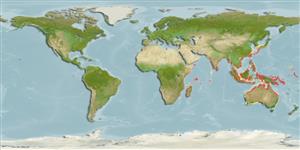>
Siluriformes (Catfishes) >
Ariidae (Sea catfishes) > Ariinae
Etymology: Arius: Greek, arios, areios = dealing with Mars, warlike, bellicose (Ref. 45335).
More on author: Hamilton.
Environment: milieu / climate zone / profondeur / distribution range
Écologie
marin; saumâtre démersal; amphidrome (Ref. 51243). Tropical
Indo-West Pacific: India through neighboring coastal states (Pakistan, India, Bangladesh and Myanmar, Ref. 4833) to Singapore, South China Sea.
Taille / Poids / Âge
Maturité: Lm ? range ? - ? cm
Max length : 40.0 cm SL mâle / non sexé; (Ref. 38478); common length : 15.0 cm SL mâle / non sexé; (Ref. 4833)
Épines dorsales (Total) : 1; Rayons mous anaux: 17 - 22. Head shield smooth anteriorly with a series of granules and rugae posteriorly. Adipose fin with a large black spot. Lateral line bifurcating at the base of tail. Gill rakers present on the hind aspect of all gill arches. Dorsal spine with a filament at its tip. Moderately deep caudal peduncle, 1.5 to 2.1 (mean 1.8) in its depth. (Ref. 38478).
Body shape (shape guide): elongated.
Common in estuaries, tidal rivers and brackish water lakes. Feeds mostly on invertebrates. Caught mainly with bagnets, dipnets and bamboo stake traps, also on hook and line (Ref. 3290).
Life cycle and mating behavior
Maturité | Reproduction | Frai | Œufs | Fécondité | Larves
Kailola, P.J., 1999. Ariidae (=Tachysuridae): sea catfishes (fork-tailed catfishes). p. 1827-1879. In K.E. Carpenter and V.H. Niem (eds.) FAO species identification guide for fishery purposes. The living marine resources of the Western Central Pacific. Vol. 3. Batoid fishes, chimaeras and bony fishes part 1 (Elopidae to Linophrynidae). FAO, Rome. (Ref. 38478)
Statut dans la liste rouge de l'IUCN (Ref. 130435: Version 2025-1)
Menace pour l'homme
Traumatogenic (Ref. 58010)
Utilisations par l'homme
Pêcheries: commercial
Outils
Articles particuliers
Télécharger en XML
Sources Internet
Estimates based on models
Preferred temperature (Réf.
123201): 24.9 - 29.2, mean 28.5 °C (based on 2376 cells).
Phylogenetic diversity index (Réf.
82804): PD
50 = 0.5000 [Uniqueness, from 0.5 = low to 2.0 = high].
Bayesian length-weight: a=0.00550 (0.00351 - 0.00860), b=3.14 (3.01 - 3.27), in cm total length, based on LWR estimates for this species & (Sub)family-body (Ref.
93245).
Niveau trophique (Réf.
69278): 3.5 ±0.37 se; based on food items.
Résilience (Réf.
120179): Milieu, temps minimum de doublement de population : 1,4 à 4,4 années (Preliminary K or Fecundity.).
Fishing Vulnerability (Ref.
59153): Moderate vulnerability (39 of 100).
🛈
